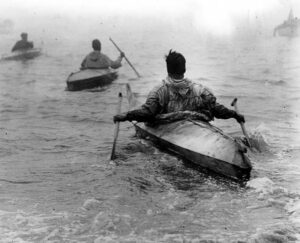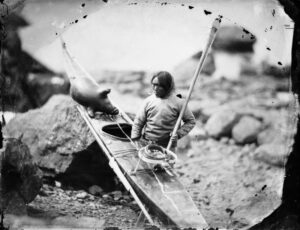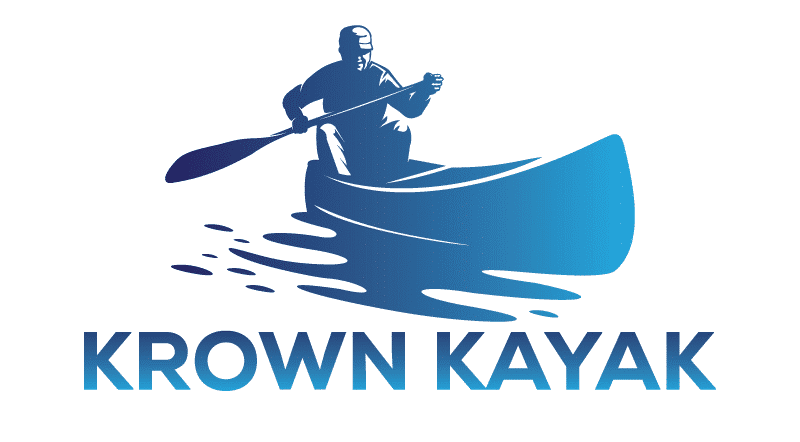Probably the best subject to explore on the maiden voyage of this website is to give a brief background on where the Kayak originated. This is the Incredible History of the Kayak and Kayaking.

Kayaks are estimated to be at the very least 4,000 years old. The division of the State Museum of Ethnology, North America of Ethnology in Munich has on display the earliest existing kayaks. The oldest can be dated back as far as 1577.
In the infancy of human culture, the kayak was principally used by the Eskimos in the northernmost parts of the world; North America, Siberia, and Greenland. The term Kayak (ki ak), implies “man-boat” or “hunter’s boat” in Eskimo.
Indigenous people, Inuit, Aleut, Yupik, and perchance Ainu hunters in subarctic regions of the world, made many types of boats for different purposes mainly for travel and hunting. The kayak served mainly for transport, yet it was a remarkable searching device, facilitating a soundless method towards one’s desired target. This was ideal for food gathering circumstances used to get closer to marine animals.
These aboriginal kayaks were designed from animal skins such as stitched seal and stretched over a wood or whalebone-skeleton frame. Then completed by connecting sinew, or tendons, with a seal skin cover.
They used these small vessels to hunt on inland lakes, rivers, and waters on the coast of the Arctic Ocean, North Atlantic, Bering Sea, and North Pacific oceans.
Kayaks are mostly made use of during summertime, primarily for searching as well as angling. The kayak’s covered deck made it more sea-worthy and able to handle drop waves than the typical canoe.

Kayak styles were different according to the specific needs and requirements of the occupant of a particular area. Early kayaks designed by occupants surrounding the Bering Strait were broader as well as much shorter. In relation, the kayaks from Greenland were both streamlined as well as low. The natives from Baffin Island designed their Kayaks wider and much longer.
Nostalgia kicked in during the 1800s where people started to explore the early ways of building canoes and kayaks of native peoples and started to develop their designs for absolute recreation and sport, exactly how we utilize them in this day and age.
In the 1860s a gentleman by the name of John MacGregor, a Scottish philanthropist, lawyer, traveler, and sportsman, was a leading individual in the development of canoeing as recreation and sport. In and around 1865 or 1866 MacGregor founded the first Canoe and Kayak organization in the form of the Royal Canoe Club.
Kayaking took a giant leap in 1924 with the formation of “The Internationalen Representation for Kanusport” formed by the canoeing associations from Austria, Germany, Denmark, and Sweden. In 1946, After World War II, the organization was rebranded and renamed the International Canoe Federation.
The recreational popularity of kayaking (along with canoeing) was introduced at the Olympic Games in 1924 with the Flatwater Racing exhibition.

12-years later, in 1936, men’s Flatwater Racing was included in an Olympic Event and for women in the 1948 Games. The first Slalom Racing events where you navigate a decked canoe or kayak through rushing 150m and a maximum of 400m long whitewater rapids course of hanging 18 to 25 downstream (green) or upstream (red) gates were conducted in the 1972 Munich Olympics.
Today, extremely few typical skin kayaks are still in usage as well as the expertise of their construction is rapidly fading. The materials that have been utilized to make a kayak have altered substantially over the years. Europeans at some point found the flexibility of the kayak, and kayaks as soon as developed with sealskins were made by Europeans with textile covers.
The products that have been made use of to make a kayak have transformed significantly with the years. Europeans at some point uncovered the versatility of the kayak, and also kayaks when made with sealskins were developed by Europeans with textile covers. This method continued up until the 1950’s when a business known as Valley Products started producing the initial fiberglass kayak. In 1984, the very first plastic kayak was presented.
As in all things as technology moves forward, kayaks continue to become stronger, lighter, and more versatile.

Now there are several types of kayaks designed with different products suitable for a selection of showing off events. Today, kayaking comes to all skill levels, providing a silent and gas-free type of awesome traveling, expedition as well as exercise.
And with COVID-19 now a daily reality and social distancing a public concern kayaking is the perfect outdoor activity that only involves a select few people being together at once. The sport or recreational activity or however you want to label it is booming in popularity.
That brings us to the love of kayaking and the basis of this website incorporating all that is this water-loving greatness!



